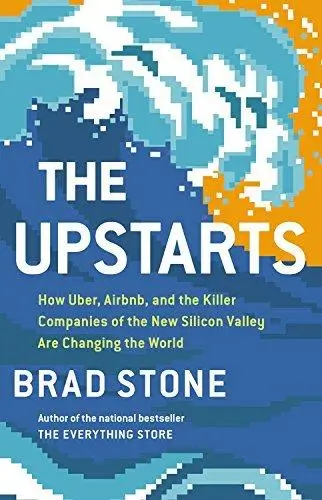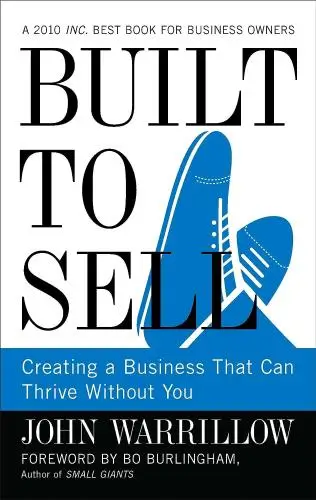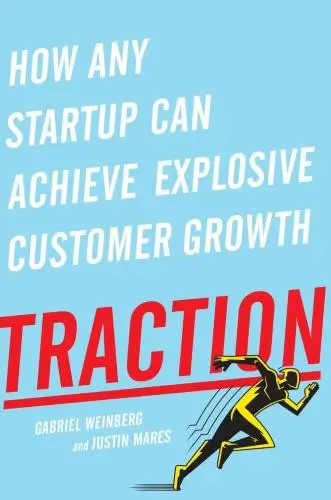
The Upstarts
How Uber, Airbnb, and the Killer Companies of the New Silicon Valley Are Changing the World
What's it about?
The Upstarts is a riveting exploration into the meteoric rise of two groundbreaking companies, Airbnb and Uber. Stone delves deep into the ambitions, struggles, and innovations that catapulted these startups from mere ideas into global powerhouses, fundamentally transforming the way we travel, work, and live. Through meticulous research and compelling storytelling, Stone provides an insider's look at the relentless drive and disruptive vision that redefine success in the digital age. A must-read for anyone fascinated by the intersection of technology, entrepreneurship, and society.
About the Author
Brad Stone is a master storyteller of the digital age, weaving intricate narratives around the titans and underdogs of the tech world. Best known for "The Everything Store: Jeff Bezos and the Age of Amazon" and "The Upstarts: Uber, Airbnb, and the Battle for the New Silicon Valley," his work dives deep into the ambitions and innovations that shaped our modern landscape. Stone's investigative rigor and vivid storytelling illuminate the human dramas behind the screens, making technology tales as compelling as any fiction.
10 Key Ideas of The Upstarts
Embrace the Power of Disruption in Traditional Industries
Disrupting traditional industries by leveraging technology can create massive opportunities.
Companies like Uber and Airbnb succeeded because they reimagined conventional services with a digital-first approach, making them more accessible, efficient, and user-friendly.
By identifying pain points within established sectors and offering innovative solutions, startups can carve out significant market shares and redefine industry standards.
Learn DeeperIdentify Industry Pain Points: Start by observing and researching the industry you're interested in. Look for inefficiencies, customer complaints, or areas where technology is underutilized. This will help you pinpoint where there's room for improvement.
Leverage Technology for Solutions: Think about how digital tools and platforms can address these pain points. Whether it's through an app, website, or software, consider how technology can make services more accessible and user-friendly.
Test Your Idea with Real Users: Before fully committing to your solution, get feedback from potential users. Create a minimal viable product (MVP) to test your idea in the market. This will help you understand if your solution truly addresses the needs you've identified.
Iterate Based on Feedback: Use the feedback from your MVP testing to refine your product or service. Be open to making changes based on what your users need and want. Continuous improvement is key to staying relevant and competitive.
Build a Community Around Your Solution: Engage with your users and build a community around your product or service. This can provide valuable insights, foster loyalty, and create brand ambassadors who can help spread the word about your innovation.
- Example
Uber reimagined the traditional taxi service by creating a mobile app that allows users to book rides with the tap of a button, making transportation more convenient and accessible.
- Example
Airbnb transformed the lodging industry by enabling homeowners to rent out their spaces to travelers, offering a more personalized and often more affordable alternative to hotels.
Focus on User Experience Above All Else
Prioritizing the user experience is crucial for gaining and retaining customers.
This involves not just intuitive design and functionality but also addressing customer needs and feedback promptly.
A seamless and enjoyable user experience fosters loyalty and word-of-mouth promotion, which are invaluable for growth in competitive markets.
Learn DeeperListen Actively to Your Users: Make it a habit to regularly seek feedback from your users through surveys, social media, or direct communication. Use this feedback to identify areas for improvement and act on them promptly.
Simplify Your Design: Review your product or service interface and remove any unnecessary steps or complications. Aim for a design that allows new users to navigate easily without needing a manual or help guide.
Optimize for Speed and Efficiency: Ensure that your website or app loads quickly and operates smoothly. Users are likely to abandon platforms that are slow or glitchy, so prioritize backend optimizations that enhance performance.
Personalize the Experience: Use data analytics to offer personalized recommendations or content to your users. This shows that you understand their needs and preferences, making the user experience more engaging and relevant.
Continuously Update and Improve: Technology and user expectations are always evolving. Commit to regular updates and improvements based on user feedback and technological advancements to keep your service fresh and appealing.
- Example
A streaming service that uses viewing history to recommend new shows and movies, making it easier for users to find content they love without extensive searching.
- Example
An e-commerce platform that simplifies its checkout process to just a few clicks, reducing cart abandonment rates and enhancing the overall shopping experience.
Leverage the Sharing Economy to Maximize Resources
The sharing economy model allows businesses to maximize the utility of resources by facilitating their shared use among individuals.
This approach reduces costs, increases accessibility, and promotes sustainability.
By building platforms that connect users with underutilized assets (like spare rooms or cars), companies can tap into new revenue streams without the need for significant capital investment.
Learn DeeperIdentify Underutilized Assets: Start by taking stock of what you own or have access to that is often left unused. This could be an extra room in your house, a car that sits in the driveway for most of the week, or even specialized tools or equipment.
Research Sharing Platforms: Look into existing platforms where you can list your assets for sharing. For rooms or homes, consider Airbnb. For cars, check out Turo or Getaround. For tools and other equipment, see if there are local community sharing initiatives or websites like Fat Llama.
Understand the Terms and Conditions: Before listing your assets, make sure you fully understand the terms and conditions of the platform, including any fees, insurance coverage, and user vetting processes.
Create an Attractive Listing: When you're ready to list, take high-quality photos and write clear, detailed descriptions of what you're offering. Be honest about the condition and availability to ensure a good experience for both parties.
Set Reasonable Prices: Research what similar assets are going for on the platform and price yours competitively. Remember, the goal is to maximize the utility of your asset, not necessarily to make a large profit off each transaction.
- Example
A person with a spare bedroom in their home decides to list it on Airbnb. They take the time to furnish it comfortably, take attractive photos, and set a competitive nightly rate based on similar listings in their area. They manage bookings through the platform, providing guests with a clean, safe, and welcoming place to stay while generating extra income.
- Example
Another individual owns a high-end camera that they only use occasionally. Recognizing the potential to share this asset, they list it on a platform like Fat Llama, setting a daily rental rate. Photographers or hobbyists who need a high-quality camera for short-term projects can rent it, ensuring the camera is utilized more frequently and the owner earns money from an otherwise underused asset.
Adopt a Data-Driven Decision-Making Process
In today's digital age, leveraging data analytics for decision-making can provide a competitive edge.
Analyzing customer behavior, market trends, and operational metrics enables businesses to make informed decisions, personalize offerings, and predict future trends.
This approach helps in optimizing strategies and operations for better outcomes.
Learn DeeperStart Small with Data Collection: Begin by identifying key areas of your business or personal projects where data can be collected easily. This could be customer feedback, website traffic, or sales data. Use tools like Google Analytics for online metrics or simple surveys for direct customer insights.
Implement Tools for Data Analysis: Once you have data, use analytical tools to make sense of it. Excel is a great starting point for beginners, while more advanced users might explore software like Tableau or Power BI. Focus on trends, patterns, and anomalies in your data.
Make Informed Decisions Based on Data Insights: Use the insights gained from your analysis to guide your decisions. For instance, if data shows customers prefer a particular product feature, consider focusing your development efforts there. Or, if website traffic spikes at certain times, plan your marketing activities around these peaks.
Continuously Monitor and Adjust: Data-driven decision-making is an ongoing process. Regularly review your data to see if your decisions are having the desired effect. Be prepared to adjust your strategies based on new data to stay ahead of the curve.
- Example
A small e-commerce business starts tracking which product pages receive the most views and time spent by visitors. They discover that a specific category has significantly higher engagement. Using this insight, they decide to expand their inventory in this category and adjust their homepage to feature these products more prominently.
- Example
A freelance graphic designer sends out a survey to past clients asking for feedback on their service. The data collected shows a high demand for a particular design style. The designer then decides to specialize further in this style, tailoring their portfolio and marketing efforts to attract similar projects.
Cultivate a Flexible and Adaptive Business Model
The ability to pivot and adapt to changing market conditions is vital for survival and growth.
Startups should remain open to evolving their business models in response to feedback, technological advancements, and shifts in consumer preferences.
Flexibility allows for quick adjustments to challenges and opportunities, ensuring long-term resilience.
Learn DeeperStay Informed: Regularly research and stay updated on the latest trends, technologies, and consumer behaviors in your industry. This will help you anticipate changes and adapt your business model accordingly.
Solicit Feedback: Actively seek feedback from your customers, employees, and industry peers. Use surveys, social media, or direct conversations to understand their needs and preferences, which can guide your adaptations.
Implement Agile Methodologies: Adopt agile practices in your project management and product development processes. This allows for more flexibility and quicker responses to change, enabling you to iterate and improve your offerings faster.
Diversify Your Offerings: Consider expanding or adjusting your product/service line to meet emerging market demands or to hedge against potential downturns in one area of your business.
Foster a Culture of Innovation: Encourage your team to think creatively and propose new ideas. A culture that embraces change and innovation is crucial for adapting your business model effectively.
- Example
Netflix transitioning from a DVD rental service to a streaming platform, and then into content creation, in response to changing consumer preferences and technological advancements.
- Example
Slack originally started as an internal communication tool for a gaming company before pivoting to become a widely used platform for team collaboration across various industries.
Deeper knowledge. Personal growth. Unlocked.
Unlock this book's key ideas and 15M+ more. Learn with quick, impactful summaries.
Read Full SummarySign up and read for free!
The Upstarts Summary: Common Questions
"The Upstarts" by Brad Stone delves into the rise of Uber and Airbnb, following the journeys of the companies from their humble beginnings to becoming disruptive forces in their respective industries. Stone's narrative skillfully weaves together the personal stories of the founders with the entrepreneurial challenges they faced, offering an intimate look into the world of startups and tech innovation.
I found myself particularly engrossed in the sections detailing the strategic decisions and controversies that surrounded both companies, such as Uber's aggressive expansion tactics and Airbnb's battles with regulators. Stone's in-depth research and access to key players provide a comprehensive view of the intense competitive landscape these companies operated in, leaving me both impressed and at times questioning the ethical implications of their actions.
Overall, "The Upstarts" is a captivating read for anyone interested in business, technology, and the stories behind successful startups. I highly recommend it for readers who enjoy books like "The Lean Startup" by Eric Ries or "Steve Jobs" by Walter Isaacson.
Experience Personalized Book Summaries, Today!
Discover a new way to gain knowledge, and save time.
Sign up for our 7-day trial now.
No Credit Card Needed

Similar Books

$100M Offers
Alex Hormozi
Principles of Marketing, Global Edition
Gary Armstrong
The 100 Best Business Books of All Time
Jack Covert
Playing to Win
A.G. Lafley
Productize
Eisha Armstrong
Start Your Own Pet-Sitting Business and More
Entrepreneur Press
The 22 Immutable Laws of Marketing
Al Ries
Lean Analytics
Alistair Croll
Built to Sell
John Warrillow
Traction
Gabriel WeinbergTrending Summaries

Peak
Anders Ericsson
Never Split the Difference
Chris Voss
Smart Brevity
Jim VandeHei
The Psychology of Money
Morgan Housel
The First 90 Days
Michael D. Watkins
Atomic Habits
James Clear
Thinking, Fast and Slow
Daniel Kahneman
The Body Keeps the Score
Bessel van der Kolk M.D.
The Power of Regret
Daniel H. Pink
The Compound Effect
Darren HardyNew Books

The ^AOxford Handbook of Job Loss and Job Search
Ute-Christine Klehe PhD
Job Interviews For Dummies®
Joyce Lain Kennedy
Job Interviews In A Week
Alison Straw
Handbook of Career Development
Gideon Arulmani
The Art of Spending Money
Morgan Housel
$100M Offers
Alex Hormozi
A Candle for Kiri
Edna Mae Holm
Principles of Marketing, Global Edition
Gary Armstrong
Serpent Rising: The Kundalini Compendium
Neven Paar
